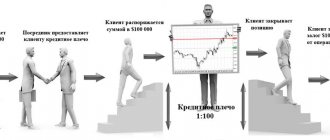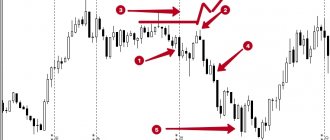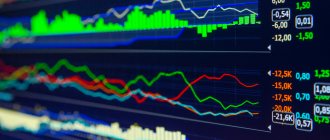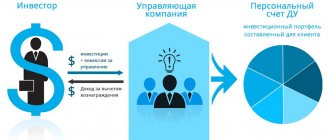In technical analysis, a significant place in determining the starting points of correction and trend reversal, and searching for optimal entry points is given to oscillator signals. At the same time, due to the set of difference (differential) algorithms used to calculate indicator readings, the instruments generate leading signals (compared to trend ones), but react even to minor changes in the asset price. As a result, there is a significant number of false signals, following which can lead to losses.
To eliminate this drawback of oscillators, traders use various filtering techniques - confirmation of signals with other indicators, use of graphical models on oscillator charts. Among the most effective, well-known and reliable options is the search for divergences.
The concept of divergence implies a discrepancy in the nature of the movement of the price chart and the oscillator line. In trading, it is customary to consider such a situation as a signal indicating a reversal or continuation of the trend with a high degree of probability. It is formed on any oscillators, is easy to recognize and can be used even if the market player does not have significant experience.
However, not all traders pay due attention to this element of technical analysis. Moreover, some are not familiar with the terms at all, and certain types of models are unknown even to experienced users.
What is divergence?
Divergence occurs on a chart when price makes a higher high, but the indicator you are using shows a lower high. When your indicator and price movement are out of sync, it means that “something” is happening on your charts and it requires your attention.
Essentially, divergence occurs when the readings of your indicators are inconsistent with the price movement.
Let's look at an example of bearish and bullish divergence. Price and indicator are not synchronized. Divergence foreshadows a market reversal.
Divergence analysis is very useful in predicting future price movements based on current indicator readings.
This event is most often associated with increased levels of volatility. The cost of a trading instrument may diverge greatly from its fair price. Increased volatility creates more profitable trading opportunities over a period of time. By paying attention to cases of strong divergence, you can take advantage of unique trading opportunities that you may not have noticed before.
Divergence Tools
Divergence forms between the price of a cryptocurrency and almost any indicator - technical or fundamental.
- The technical indicator shows the discrepancy visually.
- Fundamental is noted, for example, when unfavorable news comes out and the price continues to rise.
The situation of fundamental divergence does not take long to form, since traders have no reason to invest in cryptocurrencies despite the negative external background. Moreover, conservative and most cautious investors in such situations reduce positions, tighten stops or exit transactions completely, since they are not confident that the market will remain strong. As a result, sellers have an advantage and the price collapses.
Sites where you can see fairly complete news on cryptocurrencies - portals and aggregators like:
- https://ru.investing.com/;
- https://bitscreener.com/news.
Bitsscreener publishes materials in English, so you can use a browser with an auto-translation function.
If the investor’s interest is related to certain coins, then all news on assets appears in social feeds and on the websites of the cryptocurrencies themselves.
To search, it is better to use the aggregator coinmarketcap.com/ru, coingecko.com/ru or similar.
Just select the one you need in the table of all cryptocurrencies, click on its ticker and get to the page where you can find the latest messages in the feeds and a link to the official website of the coin.
Indicator readings
For example, we can use the MACD indicator, which focuses on using averages over several time periods. MACD uses closing prices as well as exponential moving averages.
Trading divergences has one key rule. If the price makes a higher high, the oscillator should also show a higher high. If price makes a lower low, the oscillator should also make a lower low.
Divergence can only be assessed when the price has formed:
- Higher maximum compared to the previous one.
- Lower minimum compared to the previous one.
- Double top.
- Double bottom.
Let's look at the Awesome Oscillator indicator. Divergence is only present when the histogram indicating momentum returns to the zero line. Two subsequent lows or highs where the histogram does not return to the zero line are not a valid divergence.
Hidden divergence occurs when the price makes a higher low, but the oscillator makes a lower low. In an uptrend, hidden divergence occurs when the price makes a lower low and the oscillator shows a lower low.
Divergence and the RSI indicator
One of my favorite indicators today is the RSI (Relative Strength Index) indicator. RSI compares the average price movement over a certain period.
For example, if your RSI is set to 14, it compares the bullish candles and the bearish candles for the last 14 candles. When the RSI value is low, it means that there have been more bearish candles in the last 14 candles compared to bullish candles. When the RSI reading is high, it means there have been more bullish candles.
During trends, you can use RSI to compare individual trend waves and thus assess the strength of the trend. Here are three possible scenarios for using RSI:
- When the RSI makes similar highs during an uptrend, it means the momentum of the trend is not changing. This cannot yet be considered a divergence because the strength of the uptrend is stable. Higher RSI highs do not indicate a trend reversal or weakness. It simply means that the trend is moving unchanged.
- Typically, the RSI makes higher highs during healthy and strong bullish trends. The most recent wave of a trend should have more bullish candles than the previous wave.
- When you see price making a higher high during a bullish trend but the RSI making a lower high, it means that the most recent bullish candles were not as strong as the previous price move and that the trend is losing its momentum. This is what we call divergence. In the chart below, divergence signals the end of an uptrend, and makes a downtrend possible.
Classic technical analysis tells us that a trend exists when price makes higher highs and higher lows, but as is often the case, conventional wisdom is rarely correct and usually oversimplifies the real picture.
A trader who relies only on highs and lows in his analysis of price action often misses important clues and does not fully understand market dynamics. Even though a trend may look "healthy" at first glance, it may lose its momentum at the same time if you analyze the market deeper.
Thus, divergence tells us that the dynamics of the trend are shifting and that its potential end may be very close.
It is important to know:
- The troughs and peaks on the chart and indicator must be in the same time period. For example, if the peak on the price chart on the 4-hour chart occurs at 12-00, then the peak on the indicator should also be at 12-00.
- Divergence is confirmed only if the slope of the line connecting the tops/bottoms of the indicator differs from the direction of the slope of the line connecting the price tops/bottoms. The slope must be one of the following: Ascending (increasing), Descending (decreasing), Flat.
- If you have identified a divergence, but the price has already reversed and moved in a certain direction for some time, then the divergence should be considered completed. This time “the ship has sailed.” All that can be done in this case is to wait for the formation of another wave of tops/bottoms and then start identifying divergence from the beginning.
- Divergence on longer time frames is more accurate. Fewer false signals. You also receive fewer signals, but the profit potential is huge. Divergence occurs more often on smaller time frames, but its signals are not as reliable. We recommend looking for divergence on the hourly chart or higher. Some traders use this tool on 15-minute charts or even smaller ones. However, there is a lot of noise on these time frames, so it is better not to work on them.
To make it easier, we offer, which can automatically detect the formation of divergences on all currency pairs and display all the data in a single panel window.
How to trade divergence?
Divergence does not always lead to a trend reversal, and often the price enters a consolidation phase. Keep in mind that divergence only signals the fading of momentum, but does not necessarily indicate a complete change in trend.
I strongly encourage you to add other market analysis criteria and tools to your arsenal. Divergence by itself is not strong enough. Like any trading strategy, you need to use more confluence factors.
Below we see two divergences, but the price ultimately did not reverse, and the market found itself in a state of short-term consolidation.
Instead of making trades based on divergence alone, it is best to wait until the price reaches a support or resistance level.
In the chart below, on the left side, we see an uptrend with two divergences. However, the first divergence did not fully justify itself, and the second led to a subsequent market reversal. What was the difference between them? If we look at the chart on the right, we see that the first divergence occurred in the middle of the move, and the second formed at an important resistance level.
Divergence is a powerful trading concept. A trader who understands how to trade divergences in the right context, coupled with confirming signals, can create a reliable and effective way to analyze the market.
One method of analyzing divergence is to use trend lines and trend channels. Once a market diverges, trend lines can signal the end of the current trend.
It is also always worth considering the current timeframe. As a rule, the higher the time frame, the stronger the divergence readings. The likelihood of a price reversal increases when there is divergence between price and momentum across multiple time frames.
Redrawing
Redrawing the indicator is the main reason why you will not be able to enter right at the top of the market with minimal risk.
In order to minimize the risk of entering on a false signal, you must:
- Wait until at least two candles form in the direction of the trend reversal after finding the expected peak.
- If these two candles go in the direction of the opposite trend, then it is better to wait for an impulse in your direction.
These rules do not provide a 100% probability, but significantly increase the likelihood of a price reversal
Double divergence
Double divergence can potentially improve signal quality compared to regular divergences.
As we have already written, the divergence of the RSI indicator signals a loss of momentum. The chart below shows how price rose above the high, but the RSI did not reach a new high. This tells us that the price action was not actually that strong, and although the price was moving higher, the market was not strong enough. RSI, which analyzes the strength of candles, confirms this with divergence.
The following chart example shows that price made new lows during a downtrend. Again, the RSI did not confirm this move and made higher lows, indicating that the candles moving lower were not showing bearish strength.
However, divergences are not always a reliable sign of a price reversal. This is where double divergence can serve as an additional signal.
Double divergence occurs when a series of multiple price highs (or lower lows) are formed while the indicator is printing lower highs. In the chart below we are using the MACD indicator, but you can also use the RSI or any other momentum indicator.
We see double divergence during a downtrend. Moreover, each subsequent wave becomes weaker.
The chart below shows another example of double divergence. At first we observed one divergence, but the price did not reverse and continued to decline.
The MACD then reaffirmed the downtrend and showed lower lows. Then the trend weakened, and the trend waves became shorter. The MACD is now showing double divergence and the market is turning higher.
Identification rules
It is often very difficult to determine divergence due to the fact that it is necessary to comply with the rule associated with the sequence of two peaks or troughs, however, practical experience suggests that it is not at all necessary to comply with optimal conditions to start using signals for your own purposes.
For this reason, if between 2 peaks that formed new PS lines there was a fuzzy movement with the construction of a weak peak, then the occurrence of this market movement can be ignored and you can safely use the positive aspects that the bearish divergence signal provides in this case.
Divergence and price action
Let's look at a way to trade divergence in combination with price action signals. To do this, we will use the concept of implicit divergence. That is, market analysis without using any indicators by interpreting the chart itself. As we know, in an uptrend the price must show successive highs and lows. However, with a more careful analysis of price movement, it is possible to determine when the trend loses its strength. In this case, the candles close within the range of the previous candles, and the shadows are often larger.
Here we see a strong uptrend that is showing the first signs of weakness as a pronounced pin bar appears.
Obviously, we have encountered a strong level of resistance here.
Notice how the last candles are trying to overcome previous highs. This is where we have implicit divergence.
We have a bullish bar again, but we again see price rebound from higher values.
Another bullish candle that is stuck in the range of the previous ones.
Next we see a drop in price. Moreover, if we analyze the indicators, the divergence will not be so obvious.
I encourage you to start looking at charts in a broader context. As I said, implicit divergence is just one trading idea among many others.
Convergence trading rules – use convergence to make a profit
The rules for finding an entry point to buy are no different from the algorithm discussed above for divergence, except that it will be mirrored in the opposite direction:
- After completion of the fractal formation. That is, after the close of the second candle after the highest peak candle, we enter the market. It is important that our maximum is not broken during this time. You can also install the Bill Williams Fractals indicator and wait for a reversal signal from it.
- If two bullish candles appear after the extreme, then this is an additional confirmatory filter for opening a position.
- Additional indicator analysis. For example, on a lower timeframe we look for overbought conditions on the RSI
- Price Action Patterns. A hammer, bullish engulfing or morning star will be the best signal to enter a sell. You can read more about patterns in the article...











